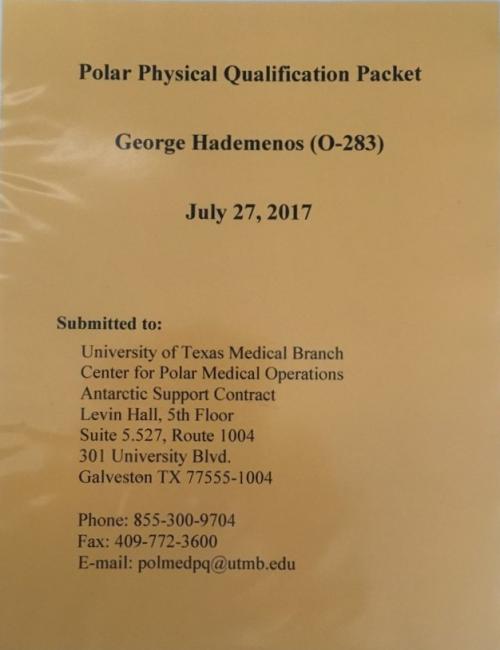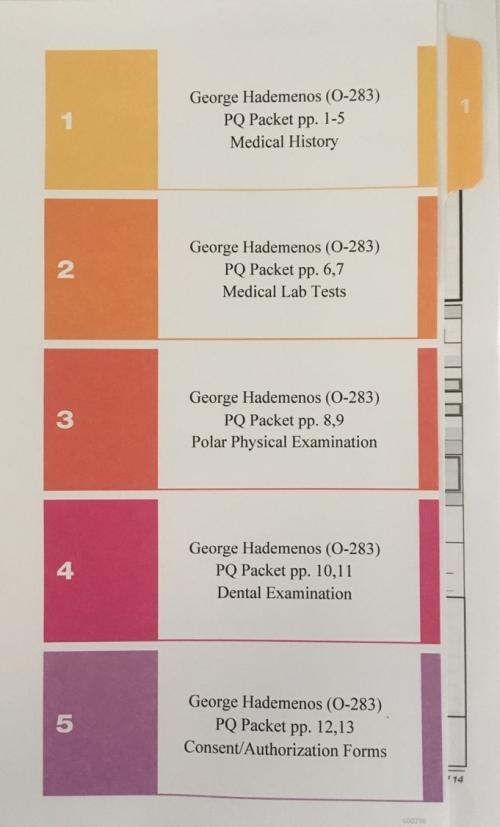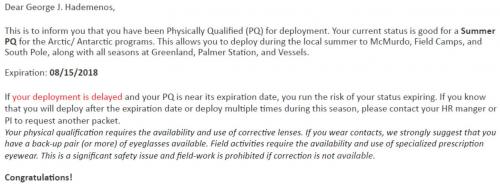PS, I Love You; PQ (Process), Not So Much
Checklists are important in everyday tasks, particularly those that involve travel. They are important as that they ensure that the passenger is fully prepared for the journey that lies ahead. This takes on a more serious note when international travel is concerned particularly with considerations to health and safety.
At PolarTREC Orientation earlier this year, the participants heading to Antarctica were fully briefed on this effort, referred to as the PQ (Physically Qualified) process. Polar science and its related endeavors are full of acronyms but this one seemed to be the most commonly used and one that sparked a sense of angst. Being PQ’ed (yep, it is such a big deal in polar scientist circles that it also earned the right to be expressed as a verb) is the primary (and actually only) major hurdle in gaining permission to fly to Antarctica. The PQ process is a rather extensive medical, dental and physical evaluation to ensure that you, more precisely your body, can withstand the extreme conditions awaiting your visit to Antarctica with a minimal risk of unexpected medical or dental emergencies. After all, there is limited access to medical or dental urgent care facilities on Antarctica, leaving one with a strong possibility of enduring excruciating pain or placed in a life-threatening situation until an evacuation can be arranged.
“Don’t do anything now with regard to appointments,” was what we were told at Orientation. “Wait for an e-mail from the USAP(abbreviation) United States Antarctic Program and the UTMB (University of Texas Medical Branch) at Galveston with the required paperwork and detailed instructions.” That’s easy for them to say and even easier for a teacher to follow. Except when you are a teacher like me. Being a teacher who likes to be prepared and tackle complex issues as quickly as possible, this left me with the only option I had available to me – wait.
So, what exactly is involved in the PQ process? Now, if you are thinking that the PQ process involves a couple of shots, some blood work, and perhaps diagnostic screening for an array of serious and potentially life-threatening conditions obtained through blood tests, you would be correct... well at least partially correct. The major components of the PQ process are outlined below with a list of specific tests required for me based on my age.
Part I: Medical History
This section is very similar to the information that you provide to a doctor upon your first visit. It is typically in a checklist form and designed to provide the doctor with a fairly complete medical assessment to help better treat you in the future. The PQ packet is no different in this regard as it requests information on medications, allergies, past hospitalizations, past surgeries, medical testing/procedures in the previous three years, vaccination history, lifestyle, and a general medical history.
Part II: Required Polar Labs
This section contained a list of all the required blood tests for someone with my age profile. The tests included (are you sitting down?):
- Complete Blood Count with Differential
- Blood Chemistries (Na; K; Cl; Ca; Glucose, Serum; Creatinine, Serum; GFR/BUN)
- Hepatic Panel (Alkatine Phosphatase; Total Bilirubin; AST (SGOT); ALT (SGPT)
- Uric Acid
- Lipid Panel (Cholesterol; HDL; LDL; Triglycerides)
- Iron Studies (Total Iron; Total Iron Binding Capacity; Iron % Saturation)
- Hepatitis B Total Core Antibody
- Hepatitis C Antibody
- (RPR) Syphilis
- Blood Type (ABO and Rh)
- Urinalysis with microscopy (and culture if positive)
- HIV
- Other: MMR Titer
Part III: Required Vaccinations & Testing
This section contained a list of all the required vaccinations and diagnostic tests for someone with my age profile. These included:
Vaccinations
- Tetanus Toxoid
- Influenza Vaccine
Testing
- Tuberculin Skin Test (PPD)
- EKG (12 lead EKG with tracing)
- Guaiac Stool Test
Part IV: Polar Physical Examination
The section involved a head to toe evaluation of my person with a recording of current vitals height, weight, blood pressure, pulse, BMI (Body Mass Index), Framingham Risk Score, and vision without correction and with correction.
Part V: Dental Examination
The dental examination required the dentist to conduct a periodontal as well as third molar evaluation. In addition to the notation of any extensive dental work on a dental chart, I was required to include: (1) a set of four original bite-wing x-rays; (2) panoramic and/or mounted full mouth survey; and (3) a periapical film of all endodontic work, crowns, and extensive restorations.
Although this seemed like a straightforward procedure and smooth sailing ahead, there were episodes of turbulence along the way. Below is a list of the major events highlighted during the PQ process or “How I Spent my Summer 2017:”
May 24 – I received the official e-mail from the UTMB at Galveston with the PQ Packet and detailed instructions. I immediately began the process of arranging medical and dental appointments, requesting evaluations, procedures, and documentation as required by the packet. On your mark, get set, Go!
June 5 – My first of several trips to my primary care physician to undergo the physical examination, provide blood (turned out to be six vials of blood for the array of blood tests), and arrange for vaccinations/tests to be conducted in subsequent visits.
June 7 – While on vacation, I received a voice mail from the doctor’s office that all lab results were good and I could pick up the results any time upon my return.
June 15 – My first scheduled appointment with my primary dentist. Based on my history with periodontal issues, I knew I would need a referral to a periodontist to undergo standard periodontal maintenance to ensure my teeth (more appropriately my gums) would be in acceptable shape for my upcoming trip. I received my periodontist referral and scheduled an appointment for the next available date/time.
June 22 – My initial appointment occurred with my periodontal specialist. An initial assessment was performed and a periodontal procedure was scheduled for the next day.
June 23 – The periodontal procedure was performed as well as x-rays taken to satisfy the requirements established according to the PQ packet. It would later turn out that the x-rays would not be acceptable – more on that in a little bit.
July 14 – A follow up appointment with the periodontal specialist to ensure that the teeth and gums were responding to the treatment provided on June 23rd.
July 26 – The final checkup appointment with the periodontal specialist to evaluate progress of the periodontal procedure and to complete the dental evaluation form in the PQ packet.
July 27 – I then prepared a notebook with all completed forms and required documentation from the PQ Packet relevant to the medical, dental and physical examinations. This notebook was sent via express mail to the UTMB at Galveston.


August 1 – I received an e-mail from the UTMB at Galveston that the dental x-rays submitted with the packet were unacceptable. It would need to be a panoramic x-ray of the entire mouth. I immediately called my primary dentist to arrange an appointment for a panoramic x-ray to be done as soon as possible. The good news: It could be done by their office. The even better news: An appointment could be scheduled for tomorrow morning. Now for the bad news: The branch office of the dentist that could perform this type of x-ray was in Irving, which was about a 45-minute drive.
August 2 – I drove to the dentist’s office in Irving for a 10:00 am appointment to have a panoramic x-ray done. Once I returned home with the panoramic x-ray film, I scanned the image and immediately e-mailed the scanned x-ray to the UTMB at Galveston.
August 3 – The following day, I received an e-mail from the UTMB at Galveston, this time with problems pertaining to the medical component of the PQ packet: More specifically, there were three issues that I needed to address: (1) it turns out that I did not validate the packet (which was easy enough for me to do); (2) the official TB test details and results needed to be submitted; and (3) the lab results from my blood work were missing reference ranges. Issues (2) and (3) prompted a return visit to the primary physician’s office to collect the requested information. Upon receipt, this information was immediately returned in response to these three areas of concern.
August 16 – And then, after almost three months since this process began (cue the harp music and a choir singing Hallelujah at the highest volume possible), I received the e-mail (no, make that THE E-MAIL):

The purpose of this journal entry is to demonstrate just how extreme the conditions of Antarctica present to scientists and how serious the National Science Foundation takes these risks. The absolute top priority for Antarctica travel is safety and minimizing risk. Acknowledging this fact did not, in my case, minimize the stress and, at times, frustration, that I experienced of collecting all of the required testing and documentation to satisfy the requirements established within the PQ packet.
Upon reflection, I am very thankful for the opportunity of engaging in the PQ process. The reason is quite evident. As a teacher, my schedule often involves commitments to my students in the form of lesson planning, tutorials, remediation, grading, and parent conferences; to my colleagues in the form of departmental meetings, PLC (Professional Learning Communities) meetings, and analysis/breakdown of common formative/summative assessments; to my campus in the form of faculty meetings, hall duty responsibilities, serving as faculty co-sponsor of Interact (a senior community service club), and ensuring I have met all of my professional development requirements. The one glaring omission from this list is me. I do not have nor am I not committed to me. I do not want to take days for a doctor’s appointment (even if it is just a checkup) or for a dentist appointment (even if it is just a cleaning). But wait, you have summers off, right? After an exhausting year in the classroom, my top 100 list of priorities during the summer involve travel, rest, and relaxation. Medical and dental appointments are 101 and 102 on that list. Simply put, my plate was full of other commitments and I did not have time for me. If it weren’t for the PQ process, I can promise you that this summer would have been like all of the previous summers, focused on anything and everything but my health. The PQ process forced me to be committed to me and my health. And for that, I am thankful.
Coming Up Next: It is a lazy Sunday at McMurdo with pretty much nothing to do. However, it would turn out that there was something to do, making Sunday anything but lazy (at least for me)!


Comments